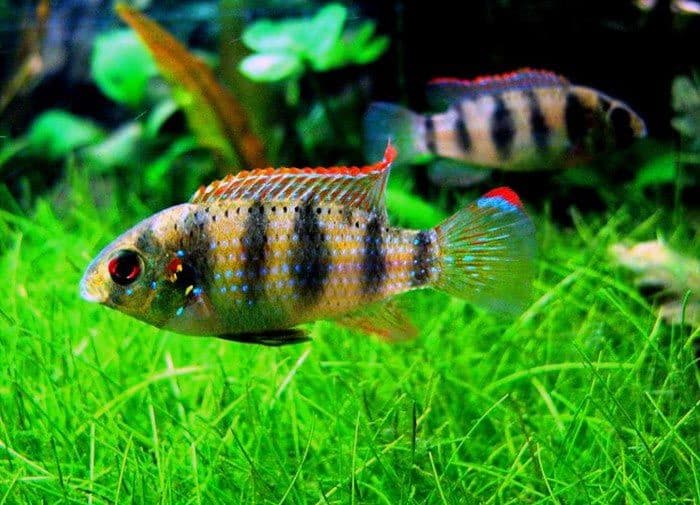
The African Butterfly cichlid is a small riverine cichlid from western Africa; specifically Sierra Leone, southeast Guinea, and western Liberia. It rarely grows to more than four inches in total length and it has a temperament quite similar to that of the kribensis – relatively peaceful, rarely digs in the substrate, and it seldom bothers plants. They form pairs and tight family groups which allow them to breed successfully even in a mixed species aquarium. Hence, it is an acceptable candidate for the community tank.
The two sexes are difficult to distinguish when they aren’t spawning. Both sexes are amber in color with blue spangling across the lateral scales from the eye to the caudal peduncle. Further, both the male and the female possess a forward-pointing black cheek stripe, a black opercular blotch, and red and white edging on their dorsal fins. Additional random black blotches appear with changes in mood, and appear intensely on the female during spawning. Also, the sexes show no discernable difference in finnage. Thus, the only observable differences between the sexes are the female’s rounded abdomen just prior to spawning and the male’s larger size- four inches vs. three inches in the female.
A group of six young fish was acquired from a local dealer and placed in a well-planted 30 gallon tank with several corydoras catfish and South American cichlids as tankmates. A number of flat stones were added to the tank as potential spawning sites. Local tap water was used and the temperature was maintained at 78 degrees. Fifty percent weekly water changes and a good diet ( various flakes, pellets, and live and frozen foods ) resulted in rapid growth and the fish reached adult size in less than six months.
At this point, the males began to stake out territories around the tank. Fighting was minimal as heavy plantings of water sprite and Java moss broke up sight lines and offered refuge to the losers. Spawning occurred immediately after a large water change and recurred at roughly ten day intervals. The female would begin to clean several stones within the male’s territory. The male would soon join her and one stone was selected as the spawning site. Spawning occurred in the usual manner- the female would lay a line of eggs across the stone , move away, and the male would follow to fertilize the eggs. This sequence was repeated until a clutch of approximately 250 eggs was deposited. The first two spawns disappeared overnight, but the third was hatched successfully with both parents tending the eggs and fry. Post-hatching, the parents moved the fry to shallow pits away from the spawning site. The fry were moved several more times before they were free- swimming, at which point they began to feed on micro-organisms picked from the plants. Micro worms and baby brine shrimp were added several days later as the fry grew rapidly. Losses were few even in a community tank, as the fry proved quite hearty and their parents were fearless in their defense.
Thus, Anomalochromis thomasi proved to be easy to breed. It is a beautiful, peaceful, and worthwhile addition to any aquarium.
Leave a Reply